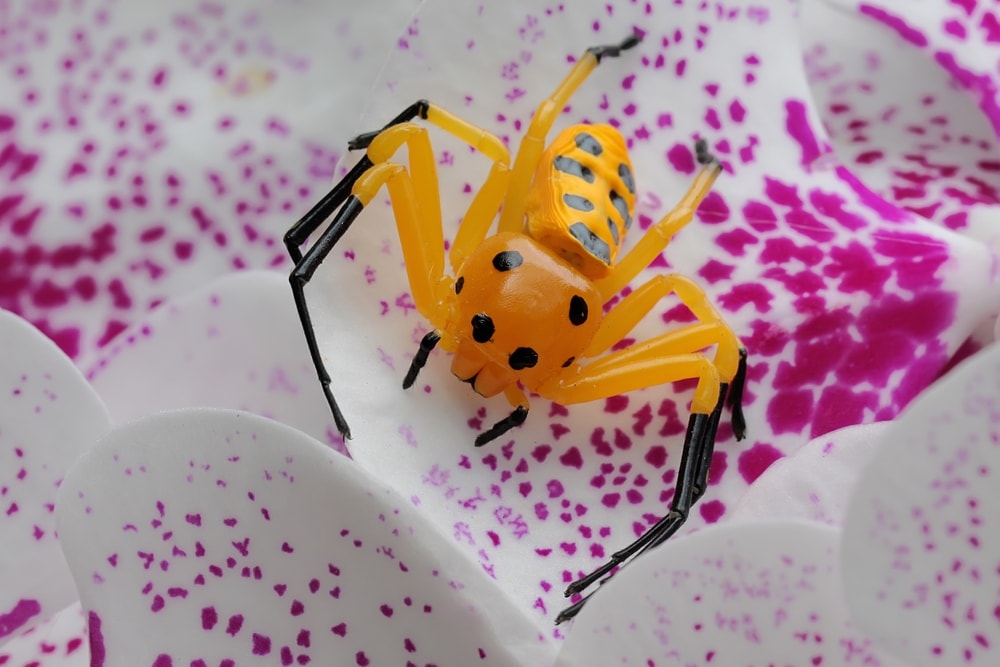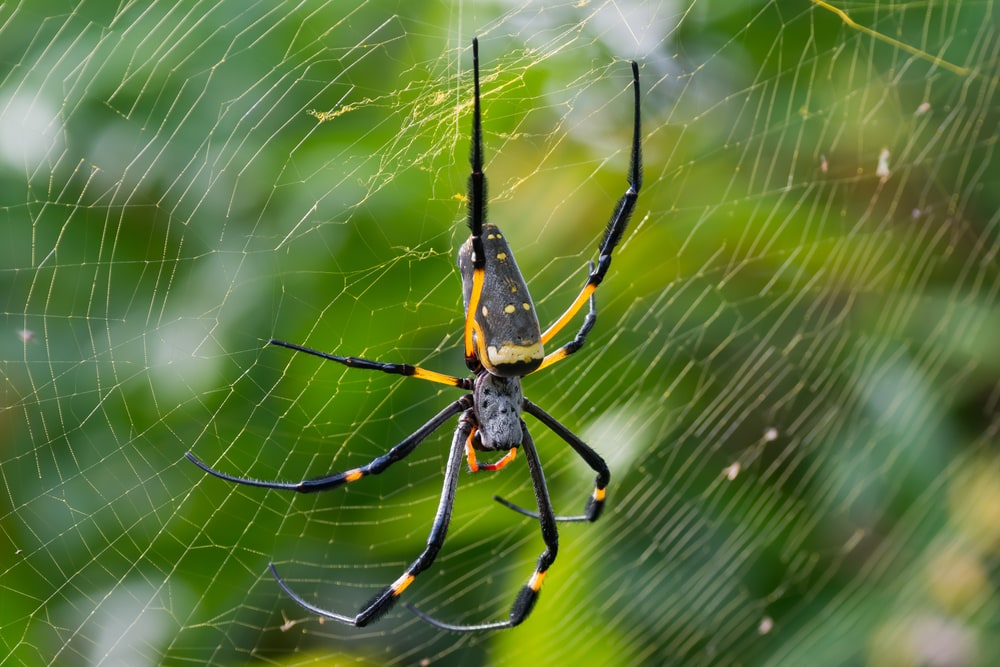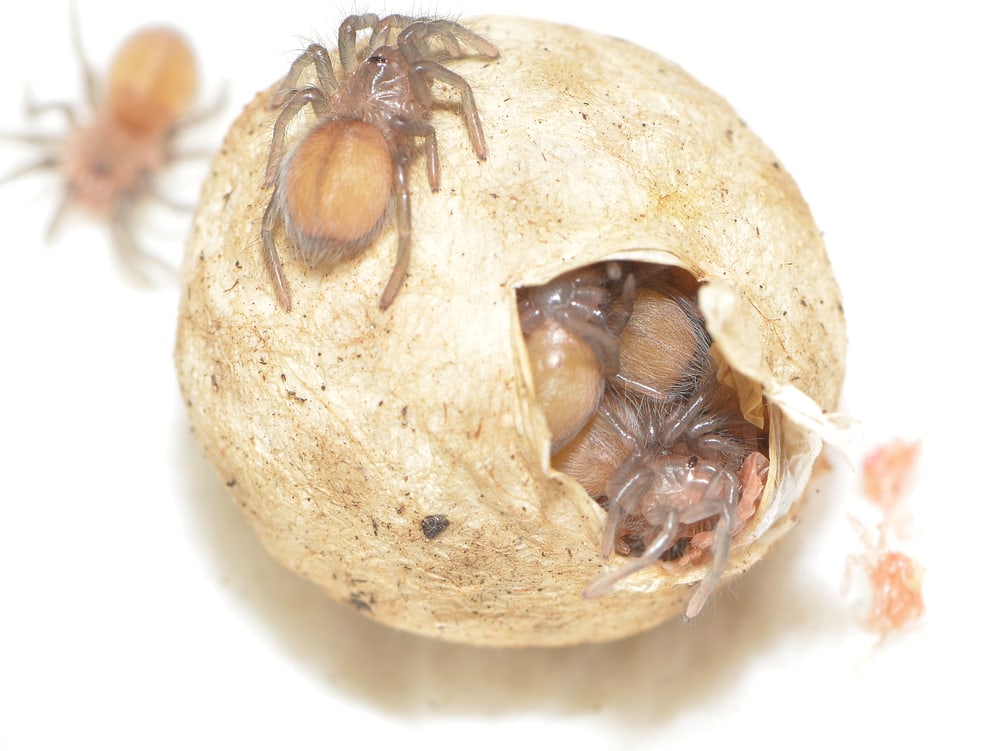Outforia Quicktake: Key Takeaways
- Male spiders face risks when they mate, mostly because the females of some species may eat their mates after mating. Males come up with different ways to stop this from happening.
- The eggs of a female spider are not fertilized right away. Instead, the female stores the sperm in a place called a spermathecae and uses it right before or after laying eggs.
- Spider species exhibit a vast range in the number of eggs they produce; it can be as few as 2 or as many as 9000. Generally, larger spiders yield more eggs.
- Spider species show sexual dimorphism, often with females being larger due to the energy needed for egg production and raising offspring. Males are usually thinner than females, and they have sense organs called palps that they use to move sperm.
- The male spider goes through a process of preparing for mating, which includes creating a sperm web and charging their palps with sperm before seeking a female mate.

Male spiders use complicated courting techniques. They must stay away from certain species of females that cannibalize them. They use even more complicated techniques to make sure it is their sperm that fertilizes the female.
Spider mothers can sometimes be “cruel” to their lovers, but many make excellent parents. They protect their eggs and young in all sorts of innovative ways. Including feeding the hapless father, or themselves, to their own young.
Read on to find out all about the weird world of spider sex and reproduction.
Sexual Dimorphism

Spiders are often sexually dimorphic. This means males and females look different. In the world of spiders, the female is often bigger. Sometimes she is one thousand times the weight of the male.
This is due to the energy needed to produce eggs and raise young. Where the male and female are of similar size, the male is more slender. In the world of spider romance, males prefer the larger lady.
Males have enlarged palps. Palps are segmented sensory appendages near the mouth of an arthropod. A spider uses them to touch and sense things. The male also uses them to transport sperm.
Spider Body Parts
If you have ever wondered what those mysterious parts of spiders are and what they are for, here’s your chance to find out.
All spiders have these features, which classify them as spiders.
- Two body sections: the cephalothorax (front) and abdomen (back).
- Eight legs
- Pedipalps (feelers near mouth)
- Chelicerae (mouthparts)
- Fangs
- Six or eight eyes
- Spinnerets: silk-producing organs
Mygalomorph spiders are more primitive. They arrived earlier in the fossil record. They have four sets of book lungs on their abdomen, which resemble the pages of a book.
They have foldable, downward-striking fangs. They have long spinnerets, which stick out when viewed from above. Tarantulas are mygalomorphs.

Araneomorph spiders are also known as ‘modern’ spiders. They evolved later. They still have book lungs, but only two sets. They have fangs that cross over like pincers.
While many of them are excellent web spinners, their spinnerets are not obvious to see. They have a spiracle, which is a small hole leading to breathing tubes.
Orb weavers, Jumping spiders, and Huntsman spiders are all from this group. Their body shape and appearance can vary widely.

Reproductive Parts of a Spider

The female spider has an opening called the epigyne. This is found on her underside, between the sets of book lungs. It is in her epigastric furrow. It looks like a black, rounded, shiny plate with two openings.
In primitive spider species, it can be difficult to see any visible reproductive parts.
The male spider has an epigastric furrow too, from which he ejects sperm. However, this isn’t what he uses to inseminate the female. He uses his copulatory palps or bulb, depending on whether he is a modern or primitive form of spider.
Primitive (mygalomorph) spider males have a single copulatory bulb that can be hard to see.
Modern spider males have two palps. These look like boxing gloves. Inside, they are structured like a spiral tube. He sucks sperm up into them, using them like a pipette. This is then used to inseminate the female’s epigastric furrow.
How Do Spiders Grow?

Spiders are arthropods. Arthropods include spiders, insects, crustaceans, and myriapods (which include centipedes and millipedes).
Spiders have a hard, chitinous exoskeleton, like most arthropods. They don’t have stretchy skin like mammals do. To grow and mature, they need to molt.
Molting is when a spider replaces its exoskeleton with a new one. This allows it to grow, as the new exoskeleton is slightly larger. Young spiders molt frequently, while older spiders don’t need to molt so much.
Mygalomorph spider females, like your friend’s pet tarantula, will molt every year for the rest of their lives. Males stop at sexual maturity. Araneomorph spiders of both sexes stop molting once they reach sexual maturity.
Below are the dried, molted exoskeletons of the Lichen Huntsman Spider.
Mating Preparations

The male spider follows some precise steps to make himself ready for mating.
Once the male spider is mature, he constructs a sperm web. This could be just one string of silk or a slightly more complex triangle of silk with several threads. He rubs his sexual organ, known as the epigastric furrow, against the sperm web.
A drop of sperm is ejaculated out of his epigastric furrow onto the sperm web.
The male sucks the sperm up into his copulatory bulb, or palps. These are near his mouth.
Once his palps are “charged” with sperm, he abstains from web building and feeding. Instead, he focuses all his energy on seeking out a female of the same species.
You May Also Like: How Long Do Spiders Live? Unraveling The Mystery Of Spider Lifespans
How Spiders Find a Mate

First, the male checks locations that he expects female spiders to be living in. Female spiders usually stay in one location. It’s the males that travel.
The female produces pheromones that travel through the air. Pheromones are chemicals that living things produce to communicate with one another. The male can pick them up and pinpoint her location.
The male will also use visual references such as color and size as he comes closer to determine if the female is the right species.
Spider Courtship

Courtship is a risky business for the male spider. As the female is so much larger, it is easy for her to reject or eat him. Yes, some female spiders eat the male after mating. It’s a myth that all spiders do it, though. Orb web spiders are one of the species that do.
There are a huge variety of tactics that different species of male spiders use to get close to the female. Here are just a few of them.
- Giving her a gift to unwrap. Male Orb-web spiders will offer their paramour a silk-wrapped gift. A fly or bug is the top choice. Some male orb-webs get sneaky and wrap up a small stone to trick the female while they mate with her.
- Drumming a rhythm Some males have to drum out exactly the right rhythm on the female’s web using their palps. If they get it wrong, the female will eat them.
- Hitching a ride. The smaller male clings onto the female’s back until her final molt, when she is ready to mate. This way, he knows he is first in line to mate with her.
- Tying her up. Some males use their silk to anchor the female down. Over 30 spider species use bondage to mate.
- Dancing. Yet more males use a complicated pattern of dance, waving their legs to mesmerize the female.
A male Nursery web spider ties his lover’s legs up in silk to stop her from eating him. The piece of silk is known as the “bridal veil”.
How Male Spiders Mate Successfully

Male spiders have several tricks up their sleeves when it comes to fertilizing females.
- Moving in early: Sometimes a male will live on the female’s web or near an immature female, waiting for her to go through the final molt and become sexually mature.
- Piggyback ride: Others will ‘piggyback’ on the larger female, in position and closer than any other males. The male then waits for the female to be receptive to his advances. own
- Blocking out the competition: In some species of spider, the male’s palp breaks off and stays in the female’s sexual opening, stopping any other males from mating with her.
Latrodectus and Lathys spider males, as well as Orb Web spiders, are known to do this clever mating stunt with their palps. Latrodectus species have even developed a ‘snapping off point’ on their palps. The Southern Black Widow is a Latrodectus species.
Mating can last from a few minutes to three hours in the case of the Baboon Spiders (Theraphosidae).
How Males Avoid Capture

Males of classic cannibal species such as Orb Web, Black Widow, and Redback spiders have worked out these ways to avoid becoming their sexual partner’s next meal.
Younger partners
Redback spider males are normally cannibalized by their partners. In this 2002 study, researchers found that redback males were mating with females who were still sexually immature. These females were not yet experienced enough to eat their mates.
The females couldn’t become pregnant right away, but that didn’t matter. They stored the sperm and used it up to two years later. The males survived to live another day and fertilize another female.
World-class jumping
Some Orb Weaver Spider males use powerful front limbs to make their getaway. They use the limbs to catapult themselves off the female and away from her web as soon as she tries to eat them. They normally use this tactic to get away from predators.
Conversely, some Redback males were observed flinging themselves onto the female’s fangs as if offering themselves as a sacrificial meal. This was also observed in the 2002 study above.
A matter of personal choice, perhaps?
Being picky
Male Tropical Tent Web spiders are the fussy ones when it comes to mating. Even if the female doesn’t eat them, the male will die soon after mating, unable to eat or build a web. This means he is a lot more picky about a partner than males of other species.
He waits until he finds a young, well-fed female who is more likely to have many eggs. Also, there is more of a chance she might not eat him.
You May Also Like: How Do Snakes Mate? An Exploration Of Their Unique Reproductive Methods
How Female Spiders Lay Eggs

The female spider’s eggs are not fertilized at the time of mating. Instead, the female holds the sperm she has received in a special holding chamber called a spermathecae. She releases this to fertilize the eggs either just before or just after she lays her eggs.
Here is the most common way for a female spider to lay her eggs:
- The female constructs a silken disc.
- She attaches her eggs to the disc. These are often expelled from her with a natural cement that hardens and dries.
- She spins a net of silk all over the eggs, forming an egg sac.
- Depending on species, she may either leave the egg sac to create more, which she will leave, or stay to guard the eggs.
- Eggs laid early in the summer hatch that same season. Eggs laid at the end of summer overwinter and do not hatch until the next year.
There are exceptions to this, for example, the Wolf spider, where the female attaches the eggs to herself. Other species create a portable egg sac, which they move to regulate temperature.
Do Spiders Have Blood?

Spiders don’t have blood with hemoglobin in it like ours does. Spiders do have a liquid called hemolymph that circulates in their system. Together with snails and octopi, this hemolymph reflects blue, not red like ours. So spiders, snails, and octopi have “blue blood”.
A compound called hemocyanin circulates in a spider’s hemolymph. Hemocyanin has an atom of copper at its center rather than an atom of iron, as hemoglobin does. Hemocyanin absorbs every color except blue, which is why it looks blue to us.
How Many Babies Do Spiders Have?

Spiders produce eggs, not live young. The exact number can vary from just 2 in the case of Oonops domesticus to 9000 in the case of the Argiope species. Generally, the bigger the spider, the more eggs it has.
Spiders make egg sacs to protect their eggs before they hatch. You can find these in your house in rarely dusted corners. Garden sheds are a good place to look. Spiders like to stay dry, so look in areas sheltered from rain.
Female Common House Spiders (Parasteatoda tepidariorum) lay roughly 250 eggs in each egg sac. They lay on average 17 egg sacs during their lifetime, which equates to 4,000 eggs. That’s a lot of baby spiders.
You May Also Like: How Do Birds Mate And Where Do Eggs Come From? A Deep Dive Into The Unique World Of Bird Reproduction
Fun Spider Facts

- The largest spider eggs belong to the Mygalomorphus genus of spiders. They are still only the size of a small pea.
- A spider can make up to seven different kinds of silk. These all come from its spinnerets, located at the back of the spider. Some of these are: dragline silk, cribillate silk, flagelliform, aciniform, and spidroin types 1–4 silk.
- Spider silk is stronger for its weight than steel. It can support 10,000 times its own weight.
How Do Spiders Mate FAQs

Which spider species eats males?
Black widow and Australian Redback spider females have a habit of cannibalizing their mates. Orb-weaving spiders will also do this.
How long do spiders live?
Mygalomorph spiders can live up to 25 years; this includes tarantulas. Mygalomorphs are large ground-dwelling spiders that live in silk-lined burrows. They are regarded as primitive spiders. The haplogyne spider can live up to 10 years. A normal life span for a spider is 2 to 3 years.
Is spider mating dangerous?
Spider mating, depending on the species, can be lethal for the male. Even if it isn’t, males tend to die very quickly afterwards due to exhaustion and a lack of food. In many species of spiders, the female dies after laying her last egg sac.
Can spiders regenerate lost limbs?
Spiders can regenerate lost limbs as long as they are not in their final molt stage. Over the course of several molts, a spider can completely regrow a lost limb.
Do baby spiders eat each other?
In some species, mostly the ones that cannibalize their males, the baby spiders that are first to hatch will cannibalize unhatched eggs and other baby spiders.








